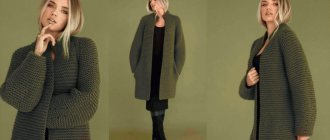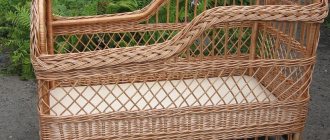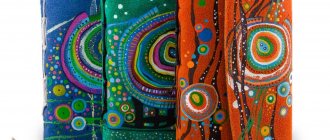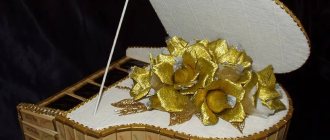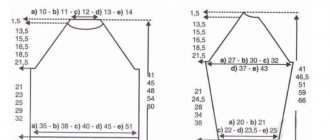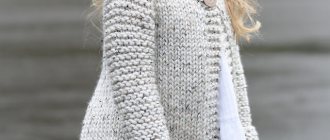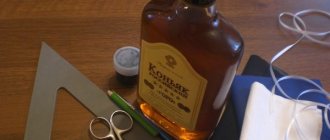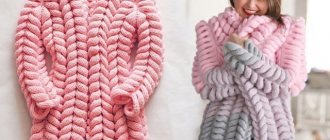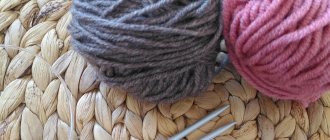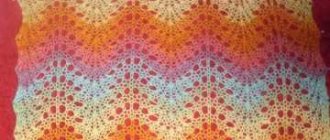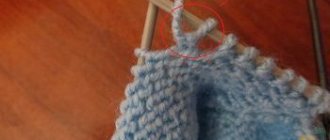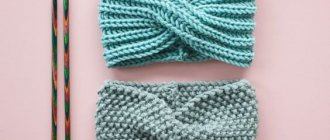“Raglan”: general meaning of the term and essence
When studying thematic materials, you can see that the name raglan is used both to designate the sleeve and the entire product. If you knit on top, then everything really turns out whole. When knitting to the bottom, you cannot do without stitching between the parts.
The shoulder parts of the shelves and backs are drawn simultaneously with the sleeves. This name owes its appearance to the famous baron from Britain, who demanded a certain size for his clothes. Next there will be a master class on how to make a raglan line.
Positive and negative aspects of the method
Here are the main advantages characteristic of raglan knitting:
- Everything is knitted in one piece, the need for stitching almost completely disappears.
- Simultaneously perform decreasing and adding for all loops. The possibility of errors and omissions is reduced to a minimum.
- Each new product does not require the preparation of separate patterns. Just one option is enough; armholes in all products are made in the same way.
- It is impossible to spoil the finished parts, so fitting can be done without any problems at any time.
- There are no loose ends after work. Thanks to this, the assembly of the product is simplified.
- Size adjustment. The product can be easily shortened, even if it has stretched somewhat during the previous wash. They also increase the length of things that have become short over time. But these rules apply to raglans that are knitted from above.
- There are no seams completely. For the manufacture of children's things, such properties are especially important. The raglan line at the top remains the easiest solution for everyone.
This method of creating clothes is not without its downsides:
- If a person is of miniature size, the line style does not suit him.
- The work can seem endless due to the large number of loops in the process.
- While the work is going on, the thing is kept suspended.
As you can see, there are many more advantages compared to the disadvantages. Therefore, this method of knitting is becoming more and more popular among craftswomen. As are the specific lines of raglan knitting on top.
Cardigan with raglan sleeves, interesting ideas from the Internet
Women's raglan cardigan knitted “Walking”
Knitted by kiashka from the Country of Mothers.
Raglan on top, knitting. Overall I'm happy with the work, it turned out the way I wanted. The color is dark blue, it is difficult to catch the shade in the photo. Alize Diva silk effect 350 m / 100 g; 100% microfiber; Color-361 (solid blue). Consumption for size 52 (Russian) is exactly 500 g.
For a description and diagram of a women's cardigan with raglan sleeves, see the link
Raglan cardigan knitted from thick yarn
Cardigan made of thick yarn with raglan knitting needles and aran and cable patterns from More2Make
An extravagant cardigan model with a voluminous pattern can be made in a short or long version. Designed by More2Make. This stylization of an old country style will suit only slender ladies: fluffy elastic and thick plaits greatly increase the size of the figure. But on a thin, slender girl, a cardigan will look simply gorgeous.
Step-by-step description of a raglan cardigan knitted
Long raglan cardigan knitted for women
A straight long cardigan with raglan sleeves can be combined with trousers, a skirt or a dress.
Raglan cardigan sizes
- Chest circumference in the armpit area – 84 (98, 112, 127, 133.5, 155) cm.
- The photo shows a cardigan size 98 cm with a 16.5 cm allowance for a loose fit.
Necessary materials:
Plymouth Yarn Homestead yarn (100% wool; 175 m / 100 grams per skein) – 7 (8, 9, 11, 11, 13) skeins, two buttons with a diameter of 2.5 cm.
Required tools:
Circular needles No. 5 and No. 5.5, 80 cm long, a set of double-pointed needles No. 5.5, stitch markers, stitch holders, tapestry needle.
Schemes and description of a raglan cardigan with knitting needles
Women's cardigan knitted without seams (raglan on top)
Women's Cardigan knitted without seams (raglan on top) size 48.
Author of the work: kobra18. Yarn 70% wool + 30% P (made in Italy) 1 skein-50g = 125m Yarn consumption 500-550g. Knitting needles No. 2.5. For a step-by-step description of a women's raglan cardigan, see the link
Raglan striped cardigan with hood
Raglan cardigan sizes: 38 (40/42) 44.
You will need:
- Yarn (90% alpaca, 5% polyamide, 5% natural wool; 140 m/50 g) – 300 (300) 350 g dark blue, 250 (250) 300 g red, 150 (200) 200 g gray and 100 ( 150) 200 g col. ecru.
- Knitting needles No. 5; circular knitting needles No. 4,5 and 5.
- 5 buttons (diameter 28 mm).
Schemes and description of a raglan cardigan with knitting needles
Women's cardigan with raglan sleeves knitted for sizes 48-52
The author of the work is kobra18 from the Country of Mothers.
Yarn NAKO 500m/100g. Knitting needles No. 3 and No. 2.5. Yarn consumption is 2.5 skeins.
For the placket I used knitting needles No. 3 (raising stitches + several rows of knit stitches) and No. 2.5 (elastic band 2*2 + closing the loops in an elastic way). raglan
Description and diagrams of women's raglan cardigan
Blue cardigan with raglan sleeves from Drops
Sizes: S – M – L – XL – XXL – XXXL
Materials: DROPS PARIS yarn from Garnstudio 600-650-700-750-850-900 grams, color No. 102, muted blue; stocking and circular knitting needles (40 and 60 or 80 cm) No. 5 mm; 6-6-6-7-7-7 buttons.
Raglan knitting density – 17 p. x 22 p. stockinette stitch = 10 cm x 10 cm.
Schemes and description of a raglan cardigan with knitting needles
Beautiful raglan cardigan knitted for women
Description and diagrams of raglan follow the link
Snow-white women's raglan cardigan knitted
Threads: 800g – NAKO Arctic 40% wool/60% acrylic, color 6053, 100g/100m for women’s raglan cardigan (circular knitting needles on cable No. 6) and 50g NAKO Bambino 25% wool, 75% acrylic 50g/130m in 2 threads, color 9029 for the bottom and collar binding (hook No. 5) and the belt (knitting needles No. 5). Women's size 46. raglan
The author of the work is Evgeniya2403 from the Country of Mothers
Brown raglan cardigan knitted for obese women
The long raglan cardigan with a trapezoidal silhouette does not have a fastener. It can be worn open or with a thin strap. Raglan bevels are emphasized by the “braid” pattern, which looks very advantageous against the background of a simple garter stitch.
Sizes (Russian): 48/50 (52/54) 56/58 (60/62)
You will need: 450 (500) 550 (600) g of brown yarn (30% sheep wool, 28% baby alpaca, 22% polyamide, 20% yak wool; 110 m/50 g); knitting needles No. 6.5 and 9; circular knitting needles No. 9; auxiliary knitting needle for braids. raglan
Description and patterns of knitting a raglan cardigan with knitting needles
Beautiful women's raglan cardigan Merle
This women's cardigan is knitted seamlessly with raglan sleeves.
Diagrams and description of a women's cardigan with raglan sleeves
Jacket, raglan cardigan knitted
YARN: any yarn with a meter of 100m per 100g is suitable. CONSUMPTION: for beige - approximately 500-600-700g. NEEDLES: 3.5-6 (depending on the density of your knitting)
Online tutorial on knitting a raglan cardigan takes place in the Country of Mothers
How to choose materials with tools?
You can't do without circular knitting needles. The thickness is greater for the main fabric, less in the case of elastic. The line should be of such length that it can accommodate everything.
The first step involves selecting images to apply to the products. Determining the number of loops for the main fabrics becomes easier if you have developed a small sample in advance.
Additional tools include:
- Markers indicating the beginning of the circle along with raglan lines.
- Several student elastic bands and other tips for knitting needles.
- Notebook.
- Centimeter rulers.
The main thing is to be patient. Especially when the work is being done for the first time. Only in this case a beautiful raglan line is obtained.
What are the rules for knitting raglans?
Both sleeves are knitted separately using this method until they reach the armholes of the back and front. The connection together is performed only after completion of the previous stages of work. The ideal option is to lay out the entire structure on a completely flat surface. Next, starting from the first row, they are assembled onto knitting needles in a circular row.
Note!
Knitted raglan - step-by-step instructions, patterns, recommendations. Photo review of the best works and new products from craftswomen
- Knitting a shawl - step-by-step instructions for making a shawl with your own hands. Tips for beginners on knitting + photo reviews
- Amigurumi ring ⭕: features of the amigurumi technique. Step-by-step DIY master class with simple knitting patterns + 180 photos
The pattern does not change when it comes to the first row. Another thing is when at least minimal fastening is planned. In this case, you will need both the front and back sides of some parts. Markers and pins mark the locations of the joints. This is necessary so that later you do not forget about the Raglan line itself.
The shoulder will be smooth for now if you start with decreases. The action must be performed at the end of each of the parts. These are usually the front loops, not the last ones. The reduction can be performed not only on one loop, but also on several at once.
The result is the part at the top in the form of a single canvas, devoid of seams. It is carried out according to a single pattern, without any errors. There are four lines of raglan where you need to create decreases. A finishing strip separates the elements from each other to make the appearance more attractive, so that a beautiful line appears.
8 decreases are required in each row. You need to look at what thickness the products and threads need. Elements go in each row, or across a row. It is important to immediately calculate the number of loops, then the scheme will be as simple as possible. A pre-linked sample will help with this.
Learning to knit raglan from below with knitting needles: a detailed description of the technique
There are two ways to knit raglan from bottom to top:
- Knitting all elements of the product separately - the finished parts (back, front and two sleeves) are put aside, without closing the last loop (use several sets of knitting needles or an additional set). Next, all the elements are cast on circular knitting needles in order: front, sleeve, back, second sleeve, and connected by knitting a row.
- Knitting begins from the bottom on circular knitting needles. Knit a single fabric - front and back, up to the height of the armholes and set aside. Next, the sleeves are knitted up to the armholes and attached to the fabric. Connect by knitting the first joint row. When all the elements are on the same knitting needles, knitting continues in the round for a sweater and in simple rows back and forth for a sweater. Close 3-4 loops at once to form armholes on the sleeves.
Calculation of loops for knitting a neckline.
Getting started is by calculating the number of neck loops required. There is no need to be alarmed about this, since there is already a ready-made calculation, a detailed description of which is given below:
- The back of the neckline is represented by a straight line, so tie it to the required length and close the loops or you can remove it with a pin.
- The upper part of the sleeve, represented by a curved line, is divided into 3 or 4 parts, while on each part the loops are not tied, then gradually transferred to a pin or secured.
- A curved line is also formed under the neck. To knit it, you need to count the number of half stitches of the neck width and divide it into three equal parts. If a residue appears, it is added to the middle part.
An example of neckline calculation: the number of neck loops is 24, then its width will consist of 12 (24/2) loops. Next we divide it into three parts: 12:3=4. Now let's move on to the distribution of loops:
- first (middle part) - once 4 loops;
- second - two times two loops;
- third - four times one loop each
Apply the obtained calculations to the pattern or record it on paper and you can start knitting the neck of the product according to the pattern, while reducing the loops on the front side. The second half of the neck is knitted in a mirror image of the first.
Decrements along raglan lines.
As a rule, when knitting bevel lines (raglan), decrease the loop at the beginning and end of the front or back rows.
However, with textured or variegated knitting, it is better to make decreases by knitting the last 2 stitches together with the purl stitch in the cone of each row.
When knitting stockings, you can use decorative decreases on the front side: “pintucks”, “flagella”, “corners”, “herringbones”, etc. Knitting sprout.
In the sewing world, a sprout refers to the neck line on the back. It is used to ensure that the product does not pull at the back and does not choke at the front.
The height of the sprout is selected in accordance with the age of the person who will own the finished product:
- for children from 0 to 3 years old, up to 1.5 cm is recommended;
- for teenagers – 3 cm;
- models ranging from sizes 42 to 50 – 5 cm;
- models with sizes above 50 – 7 cm.
Also, the height of the sprout can be determined using the formula: neck circumference/6)-1=sprout height.
Here is an example of knitting a sprout for three-year-old children:
- When knitting the neck, when 1-1.5 cm remains, you can start knitting the sprout in short rows.
- The sprout affects all the loops of the back and sleeves. We divide the sleeve loops into equal 4 parts and highlight them using markers or other methods, since it will be necessary to decrease along the raglan line in every second row, therefore, the number of sleeve loops will decrease.
- Let's start knitting the sprout itself: we start knitting a row from the beginning of the row, knit the back loops, the raglan line and the loops of the first part on the sleeve, then turn it inside out, make a yarn over and knit in the opposite direction in the same sequence, but already knit the first part of the second sleeve , turn it over to the front side, yarn over and repeat. When you reach the yarn over of the first row, you knit it together with the next loop to avoid the appearance of a hole and finish the second part, then turn the knitting over and make a yarn over in the other direction. In this sequence, 8 rows are knitted.
While working, when knitting a sprout, do not forget about the pattern and decreases along the raglan line.
What are raglan lines?
Reducing stitches before and after the dividing strip is the simplest option for raglan lines in practice. Then, when selling the product, there are no obstacles to a harmonious design and adherence to all lines.
Note!
- Knitted braids: simple patterns and the best master class for creating patterns with knitting needles. How to knit braids with your own hands + photo reviews
Knitting booties for newborns: detailed patterns for knitting booties for beginners + 150 photo reviews of the best products
- Mittens - TOP 100 photos of the best creation ideas. Description of the technique + instructions for knitting mitts with your own hands for beginners
But there are shapes that are of greater interest when knitting from below, from above. The following options are always in demand:
- Tourniquet.
- Protection,
- Christmas tree.
- Corner.
Any of these types of patterns can be displayed on the front side of the product. Then the finished version looks more unusual and beautiful. But you still can’t do it without some skills and perseverance.
It is worth considering each instruction separately to understand. And to understand how a beautiful raglan line appears with knitting needles.
Raised line on the reverse surface
The raglan line is made on the reverse surface in the form of a “spikelet”. This flagellum is knitted with a star pattern (3 out of 3), adding loops is done from crossed yarn overs. Detailed MK:
Knitting pattern in the round and in rotating rows:
Line repeat: 7 loops; 2 rows.
1st row preparatory (purl): For turning rows - 2 knits; 3 p. For knitting on circular needles - 2 purl; 3 persons
- ROW 1: P1; crossed yarn over; 1 purl; 3 out of 3 (knit, yarn over, knit); 1 purl; crossed yarn over; 1 purl.
- ROW 2: For turning rows - 1 person; facial crossed (knitting needle from left to right); 1 person; 3 purl; 1 person; facial crossed; 1 person For circular knitting - 1 purl; purl crossed (behind the front wall); 1 purl; 3 persons; 1 purl; purl crossed; 1 purl.
Tips for designing tucks
Stitches are picked up on knitting needles in odd numbers to develop a test pattern. The preparatory row is always purl. Next knit using the following pattern:
- Edge loop, followed by 3 knit stitches, 3 together with a knit stitch with a right slant. Next come the knit stitches, with 7 loops left non-knit with the edge stitch. Together with the knit stitch, 3 stitches are made with a left slant, then three more knit stitches, then an edge stitch.
- Facial.
- Purl.
- A row of purls.
- Repeat the first row.
When knitting large items, this method becomes especially relevant. Such raglan lines are distinguished by their simplicity and the absence of additional skill requirements.
“Pigtails” along the bevels of the raglan lines
From the right edge: 2 loops of the purl stitch, make a “braid” on 4 loops (= knit on 4 loops with the front stitch and cross the loops to the right in every 4th row), 1 loop of the purl stitch and knit the next 2 loops together purl. For the second bevel from the left edge: knit the 9th and 8th loops together with the purl stitch, 1 loop with the purl stitch, make a “braid” on 4 loops (= knit with the front stitch on 4 loops and in every 4th row cross stitches to the left), 2 purl loops. Decrements, as well as crossing braids, should be performed every 4th row.
How are flagella formed?
After the required sample, the work is performed in the following sequence:
The first loop is made as an edge loop in any case. The next stitch is a purl, and the next 4 are swapped with each other. The loops are removed on the right needle, without knitting. In the first 2 loops, the left knitting needle is inserted behind the work. Counting goes from the right side to the left. The right knitting needle is removed from 4 sts. Before work, they immediately begin to insert it into 3 and 4 sts.
All previous loops are returned to the left knitting needle. Next come three facial ones.
The next three loops go together; when forming them, use the following method. Each loop is transferred to the knitting needle on the right in such a way as if the front version is knitted, the knitting needle is inserted into the loops from left to right.
There is a return to the right knitting needle of all parts, knitting behind the walls behind. The remaining part is knitted; only the last of the 8 stitches are not knitted until the end of the row. The first 2 of 8 are removed on the knitting needle on the right. The same is done for the next 4, the first two of those indicated before work are removed onto the same knitting needle on the left side.
4 loops are released from the knitting needle on the right, but then it is again wound into 3 and 4, which remained unknitted. The left knitting needle should accommodate the two mentioned earlier and those for which processing has already been carried out. Finally, take 1 purl stitch and 1 edge stitch.
Knit based on the pattern. All knit stitches go. Repeat the second row.
Repeat the first row. The line length table also helps to complete projects of any complexity.
Calculation for the neck
In any sweater, the neck line in the front runs lower than along the back. This difference in height between the back and front in knitting is called "sprout".
Related article: How to wash windows so that there are no streaks left
- The back neck looks like a straight line - here, after knitting to the desired length, the loops can be closed or removed with a pin.
- The upper end of the sleeve is knitted as a curved line; for this, the remaining loops are divided into 3 sectors. The loops from all parts are not tied, they are also removed with a pin. This must be done through the row.
- If the front of the product is knitted under the neck, then the line will also be crooked. Knit a line by counting half of all neck loops and distributing them into three sectors. The remaining loops are added to the middle part.
Simultaneously with knitting the neckline, the loops along the bevel line are decreased.
Tips for counting correctly
Samples of 20 by 20 cm are considered standard. This is necessary to correctly determine the amount of materials that will be needed for further work. For every 10 cm of the pattern, the number of loops and rows is simultaneously counted.
Getting an accurate result involves multiplying numbers with each other. The correct distribution of loops to the knitting needle is important. You just need to take into account that there are not only the main components, but also wool raglan. Then knitting a raglan line gives results for many years.
What else should you consider when working independently?
In the case of seamless knitted items, a pattern ceases to be a mandatory requirement. The main thing is to pay attention to accurate calculations and correct measurements. The products are knitted from top to bottom; this method has advantages for both beginners and experienced knitters. It becomes easier for them to determine the dimensions of the raglan line from the very beginning.
The raglan line is included in many products, but it is not always possible to quickly and easily master this element right away. The main thing is attention and perseverance, as in other types of work.
It is important to avoid miscalculation; even the slightest mistakes can lead to negative consequences. You must be prepared for the fact that at first it is difficult to calculate everything in advance. Therefore, it is possible to make changes during work.
There is a high probability that the first few products will have to be completely unraveled, and then put back on again. This is a normal process of learning and mastering any skill.
Semi-raglan armhole
This type of armhole is most suitable for sports models, as it combines practicality and decorative possibilities based on the classic raglan and round armhole.
Recommendations
The back and front in the lower part are knitted as on a classic raglan, and in the upper part and on the shoulder bevels - as when making a round armhole.
Proportions
• Back : decreases for the armhole (A) are distributed diagonally equal in length to half the height of the armhole and are usually performed after 2 or 3 outer loops; straight neckline (B).
• Front : the armhole is knitted in the same way as on the back, the neckline (C) can be square, round or V-shaped.
• Shoulders : oblique line (D) with gradual decreases corresponding to 1/3 of the stitches being worked.
• Sleeves : decreases on the sleeves (E) correspond to decreases on the back and front.
How to calculate decreases
• Divide the number of front and back loops into three parts, so that the number of loops for the shoulder bevels is the same, and the part for the neckline is slightly larger.
• Start the armhole by casting off 3 or 4 stitches at once, perform the remaining decreases to half the height of the armhole: continue knitting straight to the shoulder line and for the shoulder bevel, divide the number of stitches to be cast into 3 or 4 parts.
• When making armholes on the sleeves, you need to keep in mind that the straight section at the top should be twice as large as the straight sections at the back and front. All remaining stitches on the needle should be cast off together after completing the armhole.
